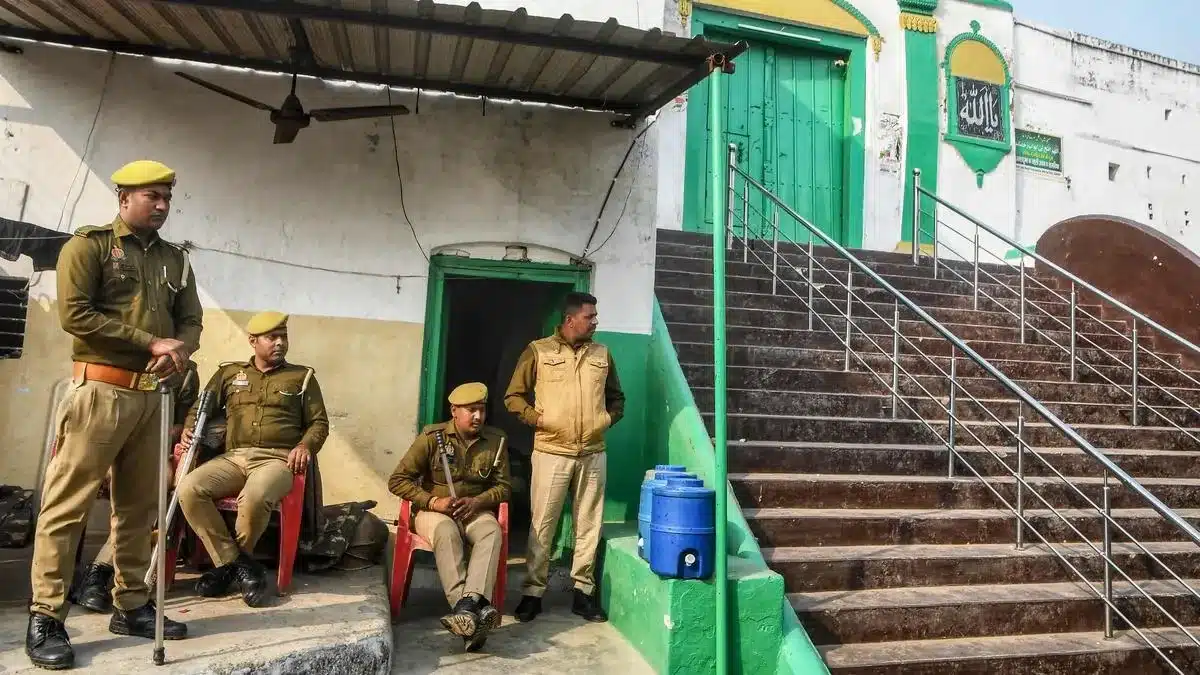What’s in today’s article?
- Why in News?
- About the Sambhal Mosque Dispute
- Historical Context of the Shahi Jama Masjid
- Legal Context of the Shahi Jama Masjid
- Broader Implications of the Sambhal Mosque Dispute
- Conclusion
Why in News?
At least four people have been killed and numerous others injured in the violence that has erupted in Sambhal, western Uttar Pradesh, since a district court ordered a survey of the Shahi Jama Masjid.
About the Sambhal Mosque Dispute:
- Background:
- A petition filed in the Sambhal district court claimed that the 16th-century Jama Masjid was built on the site of an ancient Hari Har Mandir, mirroring similar claims made about mosques in Varanasi, Mathura, and Dhar.
- The petitioners demanded a survey to ascertain the site’s historical and religious character.
- The Shahi Jama Masjid, a protected monument under the Ancient Monuments Preservation Act, 1904, is listed as a Monument of National Importance by the Archaeological Survey of India (ASI).
- This makes the case legally and culturally sensitive.
- Court-ordered surveys and resulting unrest:
- A court-ordered photographic and videographic survey was conducted peacefully with local authorities and mosque committee members present.
- However, a second survey led to violent clashes. The arrival of a petitioner accompanied by chanting crowds sparked protests near the mosque.
- Allegations surfaced of police firing, leading to the deaths of five individuals, including teenagers. Locals accused the police of excessive force and property damage, claims the police denied.
- Allegations of the locals:
- Survey order issued immediately after the petition was filed, without determining whether the Hindu side’s claims were maintainable.
- The survey began before parties could challenge the order in higher courts, bypassing critical procedural safeguards.
Historical Context of the Jama Masjid:
- Construction: During Mughal Emperor Babur’s reign (1526–1530) by his general, Mir Hindu Beg, the Jama Masjid is a significant example of early Mughal architecture.
- It is one of the three mosques built during the reign of Babur – the other two being the mosque in Panipat and the Babri Masjid in Ayodhya which was demolished in 1992.
- Architectural features:
- Built on a hill at the center of Sambhal.
- Features a large square mihrab hall with a dome, flanked by arches.
- Constructed using stone masonry and plaster, resembling structures like the mosque in Budaun.
- Repaired under Jahangir and Shah Jahan in the 17th century.
- Historical debate: Some scholars argue it may have Tughlaq-era origins, with Babur adding modifications.
- Hindu beliefs: Local tradition claims the mosque incorporates remnants of a Vishnu temple, believed to be the site of the arrival of Kalki, the tenth avatar of Vishnu.
Legal Context of the Jama Masjid:
- The Places of Worship Act, 1991: The dispute has reignited debates around the Places of Worship Act, which mandates maintaining the religious character of all sites as of August 15, 1947, barring the Babri Masjid dispute.
- Key provision: Section 3 of the Act explicitly bars the conversion of places of worship into sites for different religious denominations.
- Objective: To prevent future conflicts over religious sites and preserve India’s secular fabric.
- Challenges to the Act:
- The petition in Sambhal, seeking a change in the mosque’s religious character, directly contravenes the 1991 Act.
- Petitioners cite oral remarks by Justice D.Y. Chandrachud in 2022, suggesting the ascertainment of religious character may not violate the Act.
- Pending Supreme Court cases: Four petitions challenging the Act are under consideration, alongside disputes in Varanasi, Mathura, Dhar, and now Sambhal.
Broader Implications of the Sambhal Mosque Dispute:
- Legal precedents: Interpretation of the 1991 Act amid rising challenges.
- Historical accountability: Balancing archaeological studies with communal harmony.
- Communal peace: Preventing violence and ensuring coexistence among communities.
Conclusion: The Sambhal Mosque dispute case underscores the delicate interplay between history, law, and social harmony in India’s pluralistic society.
Q.1. What are the main features of Mughal architecture?
Mughal buildings have a uniform pattern of structure and character, including large bulbous domes, slender minarets at the corners, massive halls, large vaulted gateways, and delicate ornamentation. Examples can be found in modern-day Afghanistan, Bangladesh, India and Pakistan.
Q.2. What are the Monuments of National Importance (MNIs)?
MNIs are ancient and historical monuments, archaeological sites, and remains that are designated by the ASI under the Ancient Monuments and Archaeological Sites and Remains (AMASR) Act 1958. The ASI is responsible for the protection and maintenance of MNIs.
News: What is the controversy around the Sambhal mosque? | IE
Last updated on June, 2025
→ UPSC Notification 2025 was released on 22nd January 2025.
→ UPSC Prelims Result 2025 is out now for the CSE held on 25 May 2025.
→ UPSC Prelims Question Paper 2025 and Unofficial Prelims Answer Key 2025 are available now.
→ UPSC Calendar 2026 is released on 15th May, 2025.
→ The UPSC Vacancy 2025 were released 1129, out of which 979 were for UPSC CSE and remaining 150 are for UPSC IFoS.
→ UPSC Mains 2025 will be conducted on 22nd August 2025.
→ UPSC Prelims 2026 will be conducted on 24th May, 2026 & UPSC Mains 2026 will be conducted on 21st August 2026.
→ The UPSC Selection Process is of 3 stages-Prelims, Mains and Interview.
→ UPSC Result 2024 is released with latest UPSC Marksheet 2024. Check Now!
→ UPSC Toppers List 2024 is released now. Shakti Dubey is UPSC AIR 1 2024 Topper.
→ Also check Best IAS Coaching in Delhi





















